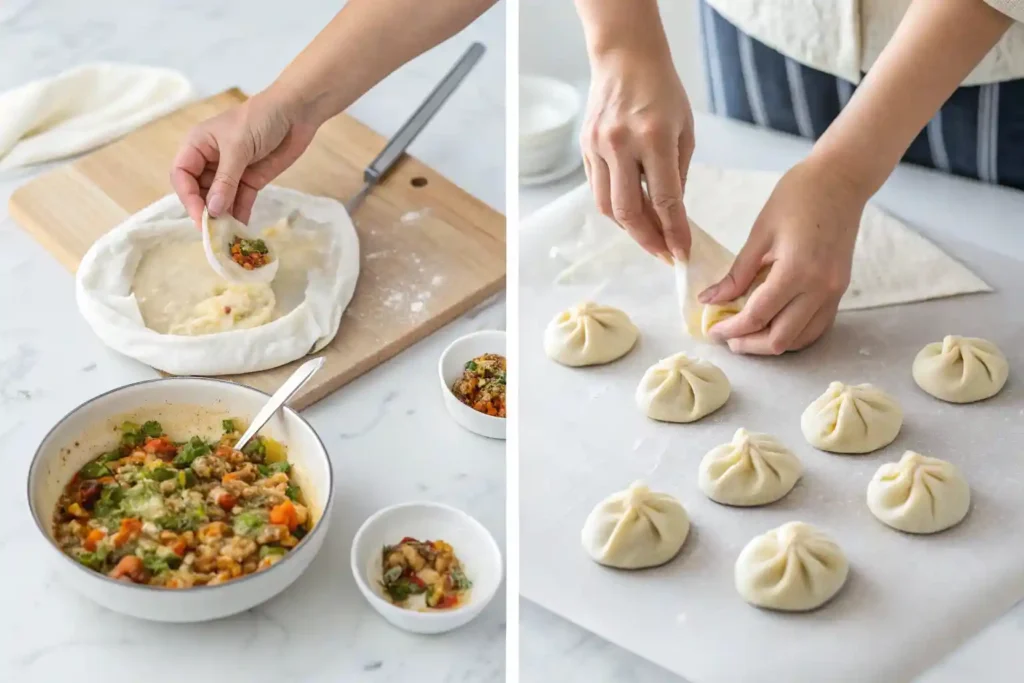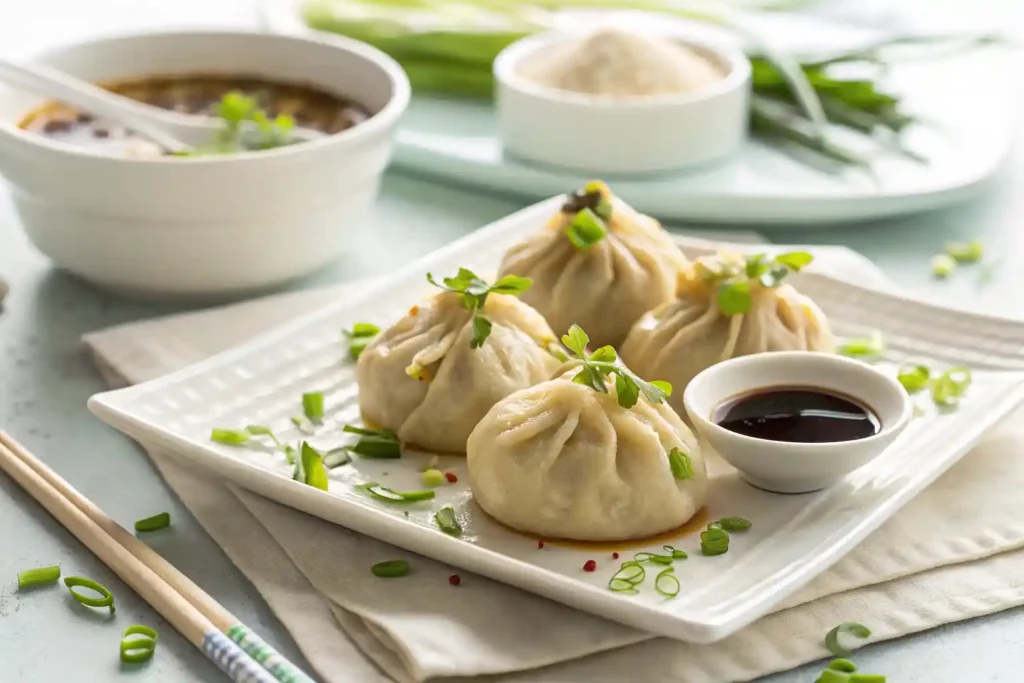Making vegetarian soup dumplings at home might sound like a daunting task, but trust me, it’s easier than you think! These little pockets of joy, filled with a savory broth and a delicious plant-based filling, are a treat for the senses. Whether you’re a seasoned cook or a curious beginner, this guide will walk you through everything you need to know—from the ingredients to the techniques that’ll make your dumplings restaurant-worthy.
In this article, we’ll explore the origins of soup dumplings, the ingredients you’ll need, and step-by-step instructions to create your own. We’ll also share tips, tricks, and variations to help you customize your dumplings to perfection. By the end, you’ll not only know how to make these delightful bites but also how to serve them like a pro. Let’s dive in!
Table of contents
1. Introduction to Vegetarian Soup Dumplings
What Are Vegetarian Soup Dumplings?
Soup dumplings, also known as xiao long bao, are a type of Chinese steamed dumpling traditionally filled with meat and a rich, gelatin-based broth. When steamed, the gelatin melts, creating a pocket of soup inside the dumpling. But here’s the twist—vegetarian soup dumplings swap out the meat for plant-based ingredients while keeping all the flavor and texture intact.
These dumplings are a testament to how versatile and creative vegetarian cooking can be. Instead of pork or chicken, the filling often includes a mix of mushrooms, tofu, and other umami-packed ingredients. The soup itself is made using a flavorful vegetarian broth, thickened with plant-based substitutes like agar-agar or konjac powder.
Originating in the Jiangnan region of China, soup dumplings have become a global sensation. While the traditional version is still the most popular, vegetarian and vegan variations are gaining traction as more people embrace plant-based diets.
Why Choose Vegetarian Soup Dumplings?
Why go vegetarian with your soup dumplings? For starters, they’re a healthier alternative to the meat-filled version. Packed with vegetables and plant-based proteins, they’re lower in fat and cholesterol but still bursting with flavor.
Plus, they’re perfect for anyone following a vegetarian or vegan lifestyle—or even for those who just want to try something new. With the rise of plant-based eating, vegetarian soup dumplings are a great way to enjoy a classic dish without compromising on taste or ethics.
Not to mention, making them at home is a fun and rewarding experience. You get to control the ingredients, experiment with flavors, and impress your friends and family with your culinary skills. So, whether you’re a dumpling enthusiast or a curious foodie, vegetarian soup dumplings are a must-try!
2. Ingredients for Vegetarian Soup Dumplings
Essential Ingredients for the Dumpling Dough
The foundation of any great dumpling is its dough. For vegetarian soup dumplings, you’ll need all-purpose flour, water, and a pinch of salt. These simple ingredients come together to create a pliable, elastic dough that’s easy to work with. If you’re looking for a healthier twist, you can substitute whole wheat flour or even experiment with gluten-free options.
The key to perfect dough is hydration. Add water gradually while kneading to ensure the dough is soft but not sticky. Let it rest for at least 30 minutes to relax the gluten, making it easier to roll out.
Vegetarian Soup Filling: Key Ingredients
The filling is where the magic happens. A mix of finely chopped mushrooms, tofu, and aromatics like garlic and ginger creates a rich, umami-packed base. Mushrooms, especially shiitake or portobello, are excellent for mimicking the meaty texture and flavor of traditional dumplings.
To enhance the flavor, add soy sauce, sesame oil, and a touch of rice vinegar. You can also include finely diced vegetables like carrots, cabbage, or scallions for added texture and nutrition.
How to Make the Soup Base Without Gelatin
Traditional soup dumplings rely on gelatin to create the soup pocket, but for a vegetarian version, plant-based substitutes like agar-agar or konjac powder work wonders. Agar-agar, derived from seaweed, is a natural thickener that sets the broth into a jelly-like consistency.
Start by simmering a vegetable broth with aromatics like onions, garlic, and ginger. Add agar-agar according to the package instructions, then pour the mixture into a shallow dish to set in the fridge. Once firm, cut it into small cubes to mix with the filling.
3. Step-by-Step Guide to Making Vegetarian Soup Dumplings

Preparing the Dough
Start by combining your flour, water, and salt in a large bowl. Knead the mixture until it forms a smooth, elastic dough. Cover it with a damp cloth and let it rest for 30 minutes. This step is crucial for achieving a dough that’s easy to roll and shape.
Making the Soup Base
Simmer a pot of vegetable broth with aromatics like garlic, ginger, and scallions. Add soy sauce and sesame oil for depth of flavor. Stir in agar-agar while the broth is still hot, ensuring it dissolves completely. Pour the mixture into a shallow dish and refrigerate until it sets.
Creating the Filling
In a skillet, sauté mushrooms, tofu, and your choice of vegetables with garlic and ginger. Season with soy sauce, sesame oil, and a pinch of white pepper. Once the mixture cools, fold in the soup cubes, ensuring they’re evenly distributed.
Assembling the Dumplings
Divide the dough into small, equal portions and roll each into a thin circle. Place a spoonful of filling in the center, then carefully pleat the edges to seal the dumpling. Make sure the top is tightly closed to prevent the soup from leaking out during cooking.
Cooking the Dumplings
Steam the dumplings in a bamboo steamer lined with parchment paper or cabbage leaves to prevent sticking. Steam for 8–10 minutes, or until the dough turns translucent.
4. Tips and Tricks for Perfect Vegetarian Soup Dumplings
Common Mistakes to Avoid
Making vegetarian soup dumplings can be a little tricky, especially if it’s your first time. But don’t worry—avoiding a few common mistakes can make a big difference.
One of the biggest problems is overfilling the dumplings. While it’s tempting to pack in as much filling as possible, this can cause the dumplings to break during steaming. Instead, use a small spoon to measure the filling and leave enough space to seal the edges properly.
Another common problem is dough that’s too thick or too thin. Thick dough can overpower the soft filling, while thin dough may tear easily. Aim for a thickness of about 1–2 millimeters when rolling out the wrappers.
Lastly, don’t skip the resting time for the dough. This step helps soften the gluten, making the dough easier to work with and less likely to shrink when rolled.
Pro Tips for Better Results
For the best results, use a bamboo steamer. It not only cooks the dumplings evenly but also adds a light, natural flavor. Line the steamer with parchment paper or cabbage leaves to stop sticking.
When pleating the dumplings, keep your fingers slightly wet to help seal the edges. Practice makes perfect, so don’t worry if your first few dumplings don’t look perfect.
If you’re planning to make a big batch, freeze the uncooked dumplings on a tray before moving them to a freezer bag. This way, you’ll always have a quick, homemade snack ready to steam.
5. Variations of Vegetarian Soup Dumplings
Regional Variations and Flavors
Soup dumplings may have started in China, but their tastes and fillings have changed in different places. For a fun twist, try adding kimchi to your filling for a Korean-style version. The tangy, spicy flavor goes perfectly with the tasty broth.
Another option is to use jackfruit as a meat replacement. Its stringy texture is like shredded meat, making it a great choice for the filling. You can also try lentils or chickpeas for a protein-rich option.
For a Japanese-style version, add miso paste to your broth and filling. The deep, rich taste of miso takes the dumplings to a whole new level.
Vegan Soup Dumplings: A Step Further
If you want to make your dumplings fully vegan, it’s easier than you think. Replace any butter or milk-based ingredients in the dough with plant-based options. Coconut oil or vegan butter works well to add richness.
For the filling, stick to vegetables, tofu, and mushrooms. You can also add nutritional yeast for a cheesy, rich flavor.
For the soup base, agar-agar or konjac powder is still your best choice for a gelatin-free option. Just make sure to use a good vegetable broth to keep the soup tasty.
6. Serving and Pairing Suggestions

How to Serve Vegetarian Soup Dumplings
Serving vegetarian soup dumplings is all about presentation and enhancing the experience. Once steamed, transfer the dumplings carefully to a serving plate using a slotted spoon or tongs to avoid tearing the delicate wrappers.
Traditionally, soup dumplings are served with a simple dipping sauce made of soy sauce, rice vinegar, and a touch of sesame oil. For an extra kick, add freshly grated ginger or a drizzle of chili oil. Serve the sauce in small bowls so everyone can dip their dumplings to their liking.
To enjoy the dumplings, use chopsticks to pick one up and place it on a soup spoon. Take a small bite to release the flavorful broth, then sip the soup before eating the rest of the dumpling. This method ensures you savor every layer of flavor without burning your mouth!
Perfect Pairings for Soup Dumplings
Soup dumplings are delicious on their own, but pairing them with complementary dishes can elevate your meal. A light vegetable stir-fry or a crisp cucumber salad makes a refreshing side dish. You can also serve them with a bowl of hot and sour soup or miso soup for a comforting, well-rounded meal.
For drinks, green tea or jasmine tea pairs beautifully with the dumplings, balancing their rich flavors. If you’re in the mood for something cold, a sparkling water infused with lemon or cucumber is a great choice.
7. Frequently Asked Questions
Can I Freeze Vegetarian Soup Dumplings?
Absolutely! Freezing soup dumplings is a great way to save time and enjoy them later. Arrange the uncooked dumplings on a tray lined with parchment paper, making sure they don’t touch each other. Once frozen solid, transfer them to an airtight container or freezer bag.
When you’re ready to cook, steam the dumplings directly from frozen—no need to thaw. Just add a couple of extra minutes to the steaming time.
What’s the Best Way to Reheat Leftover Dumplings?
To reheat leftover dumplings, steaming is the best method to preserve their texture and flavor. Place them in a steamer for 3–5 minutes until heated through. Avoid microwaving, as it can make the wrappers tough and chewy.
Can I Make the Dough Gluten-Free?
Yes, you can make gluten-free dumpling dough using a mix of gluten-free all-purpose flour and xanthan gum. Keep in mind that gluten-free dough can be more delicate, so handle it gently when rolling and pleating.
What’s a Good Substitute for Agar-Agar?
If you don’t have agar-agar, you can use konjac powder or even cornstarch as a thickener for the soup base. However, agar-agar is preferred for its ability to set the broth into a firm gel, making it easier to work with.
Conclusion
In conclusion, vegetarian soup dumplings are more than just a meal—they’re an experience. From the joy of crafting each dumpling to the satisfaction of savoring the rich, flavorful broth, this dish is a celebration of creativity and taste. Whether you make them from scratch or opt for a ready-made option like the Vegetarian Soup Dumpling Trio, these dumplings are sure to impress.
So, gather your ingredients, roll up your sleeves, and dive into the world of dumpling-making. And if you’re looking for more inspiration, check out our Village Soup Recipe for another comforting, plant-based dish to enjoy. Happy cooking!

